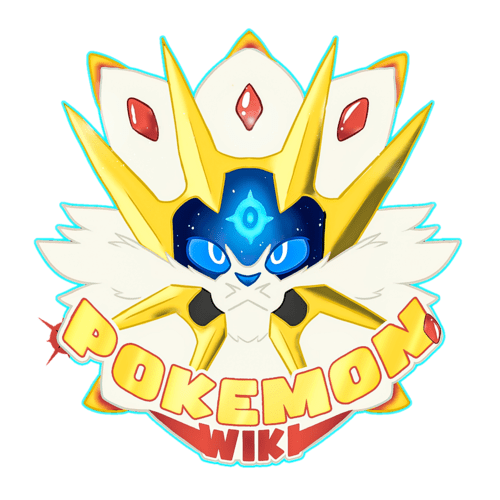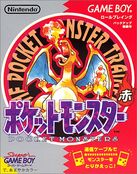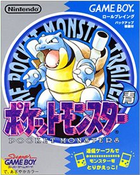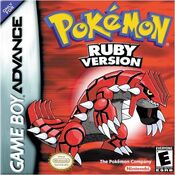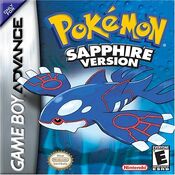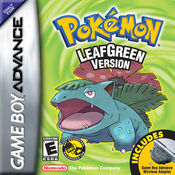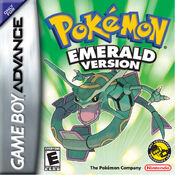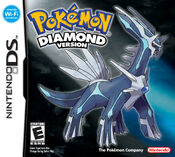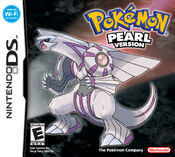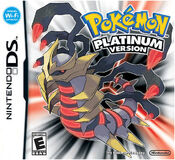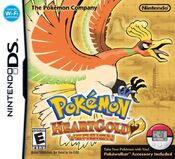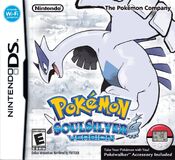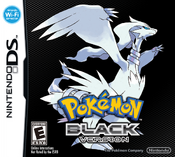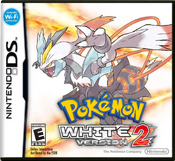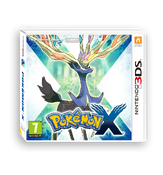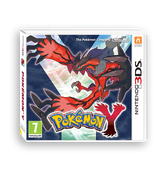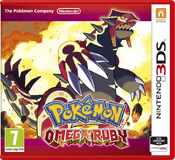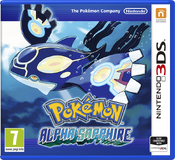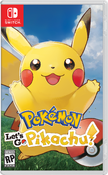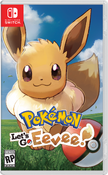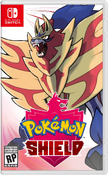m (did a mistake) Tag: Visual edit |
|||
| (31 intermediate revisions by 16 users not shown) | |||
| Line 1: | Line 1: | ||
| − | [[File:PokémonLogo(Eng).png|thumb |
+ | [[File:PokémonLogo(Eng).png|thumb|The official logo for the Pokémon franchise since 1998.]] |
| − | + | {{For|other uses|Pokémon}} |
|
| − | '''Pokémon''' is the name of the franchise, and originally, a series of video games, TV shows and more developed by the company |
+ | '''Pokémon''' is the name of the franchise, and originally, a series of video games, TV shows and more developed by the company [[Game Freak]] and published by [[Nintendo]]. The name "Pokémon" is from the shortened katakana form of Pocket Monsters (ポケモン, romanized ''Pokemon''), ポケットモンスター ''(Poketto Monsutaa)'' in full in Japanese, although the franchise name may even be shortened to Pokémon as well sometimes. Although several spinoffs for other Nintendo systems have been released, the main series games are exclusive to Nintendo's hand-held platform, for which 18 games have been released, as well as 6 remakes. Pokémon was created by [[Satoshi Tajiri]], who still has a hand in the production of the games. Pokémon was created in 1995. |
==Gameplay== |
==Gameplay== |
||
| − | The main Pokémon games all center around the strategic manipulation of creatures called [[Pokémon (creature)|Pokémon]], from which the series takes its name. In the games, the player takes the role of a male or female human who has just received a license to catch Pokémon. The player usually goes to the local [[Pokémon Lab]] to receive a [[Starter Pokémon]]. In every main series game, the player is given a choice of three Pokémon; a [[ |
+ | The main ''Pokémon'' games all center around the strategic manipulation of creatures called [[Pokémon (creature)|Pokémon]], from which the series takes its name. In the games, the player takes the role of a male or female human who has just received a license to catch Pokémon. The player usually goes to the local [[Pokémon Lab]] to receive a [[Starter Pokémon]]. In every main series game, the player is given a choice of three Pokémon; a [[Grass-type]], a [[Fire-type]], or a [[Water-type]]. A person possessing a Pokémon that trains it is called a [[Pokémon Trainer]]. |
Using their first Pokémon, players are now usually free to set off on their own adventure, in which they will collect [[Badges]] by defeating [[Gym Leader]]s. Once the player has collected eight badges, they can battle the [[Elite Four]]; four representatives of the [[Pokémon League]] that are considered the best Trainers in their respective region. |
Using their first Pokémon, players are now usually free to set off on their own adventure, in which they will collect [[Badges]] by defeating [[Gym Leader]]s. Once the player has collected eight badges, they can battle the [[Elite Four]]; four representatives of the [[Pokémon League]] that are considered the best Trainers in their respective region. |
||
| − | Another goal of the game is to try to catch every Pokémon available; in the [[Generation I|first Generation]], there were 151 Pokémon available, but with every new Generation the number of Pokémon increases. Currently, there are |
+ | Another goal of the game is to try to catch every Pokémon available; in the [[Generation I|first Generation]], there were 151 Pokémon available, but with every new Generation the number of Pokémon increases. Currently, there are 898 known Pokémon, and eight regions/generations, with the possibility of more being introduced in every new [[Generation]]. |
| − | Pokémon can be caught by weakening them with other Pokémon, and then capturing them in a [[Poké Ball]], where they can be stored for future use, to battle and help capture more Pokémon. Each Pokémon has a health gauge, and whomever gauge runs out first loses; however, a trainer can have several Pokémon, so if one Pokémon's gauge reaches zero (called "[[Faint]]ing"), they can send out another Pokémon. Each trainer can carry a maximum of 6 Pokémon although many more can be caught and stored in a [[PC]]. In order to try to knock out the opposing Pokémon, order your Pokémon to attack the opposing team's |
+ | Pokémon can be caught by weakening them with other Pokémon, and then capturing them in a [[Poké Ball]], where they can be stored for future use, to battle and help capture more Pokémon. Each Pokémon has a health gauge, and whomever gauge runs out first loses; however, a trainer can have several Pokémon, so if one Pokémon's gauge reaches zero (called "[[Faint]]ing"), they can send out another Pokémon. Each trainer can carry a maximum of 6 Pokémon although many more can be caught and stored in a [[PC]]. In order to try to knock out the opposing Pokémon, order your Pokémon to attack the opposing team's Pokémon. Pokémon can learn up to four attacks, although there are many more attacks that they are capable of learning, so you can replace one of your moves when they are ready to learn a move. When all of a Trainer's Pokémon have fainted, the trainer must depart to a Pokémon Center and give up an amount of money. |
==History== |
==History== |
||
| Line 19: | Line 19: | ||
In 1982, Tajiri formed a magazine with a few of his friends dedicated to video games. The name of this magazine was ''[[Game Freak]]''. Over the years, Game Freak's focus changed from covering gaming news into creating games — they officially announced themselves as a video game developer in 1989, and released their first game, ''Mario & Yoshi'', in 1991, for both the Game Boy and the NES. |
In 1982, Tajiri formed a magazine with a few of his friends dedicated to video games. The name of this magazine was ''[[Game Freak]]''. Over the years, Game Freak's focus changed from covering gaming news into creating games — they officially announced themselves as a video game developer in 1989, and released their first game, ''Mario & Yoshi'', in 1991, for both the Game Boy and the NES. |
||
| − | They subsequently released several other games, but in 1995, they struck gold; they, along with the help of Creatures and Nintendo, released ''Pocket Monsters Akai'' and ''Pocket Monsters Midori'' in Japan. The games were both a hit, with ''Akai'' doing best, and Nintendo decided to translate the games to English and release them in North America and Europe. Before this, they remade the games with the improved ''Pocket Monsters Blue'', and thus incorporated the improvements into the two games to be released in North America. Since ''Pocket Monsters'' was already trademarked by another company in the United States, they needed to change the name – so, they just combined the words to form ''Pokémon''. Since Midori did not sell well, they decided to change some aspects of it for the American release — including changing the name from the translated ''Green'' to ''Blue'' (although a "Blue" version was also released in Japan earlier, which improved on the original games). ''[[Pokémon Red]]'' and ''[[ |
+ | They subsequently released several other games, but in 1995, they struck gold; they, along with the help of Creatures and Nintendo, released ''Pocket Monsters Akai'' and ''Pocket Monsters Midori'' in Japan. The games were both a hit, with ''Akai'' doing best, and Nintendo decided to translate the games to English and release them in North America and Europe. Before this, they remade the games with the improved ''Pocket Monsters Blue'', and thus incorporated the improvements into the two games to be released in North America. Since ''Pocket Monsters'' was already trademarked by another company in the United States, they needed to change the name – so, they just combined the words to form ''Pokémon''. Since Midori did not sell well, they decided to change some aspects of it for the American release — including changing the name from the translated ''Green'' to ''Blue'' (although a "Blue" version was also released in Japan earlier, which improved on the original games). ''[[Pokémon Red]]'' and ''[[Pokémon Blue]]'' were both ''very'' successful in North America, and a series was born. The past English-language catchphrase was: "Gotta Catch 'em all!" |
| − | ==Game |
+ | ==Game releases== |
The games are generally released in pairs. For example, two games will be immediately released that are basically the same, except with several minor changes, and later, another improvement upon the last two games will be released. After this, work will begin on a new pair, which will have a vastly different story and various gameplay improvements. Examples of this are ''[[Pokémon Red and Blue Version|Pokémon Red and Blue]]'', which are generally the same game, except certain Pokémon can only be obtained in either one. Shortly after the release of ''Pokémon Red'' and ''Blue'', an improvement on these games was released; [[Pokémon Yellow Version: Special Pikachu Edition|Pokémon Yellow]], which featured improved color, and the addition of a [[Pikachu]] which followed the main character. |
The games are generally released in pairs. For example, two games will be immediately released that are basically the same, except with several minor changes, and later, another improvement upon the last two games will be released. After this, work will begin on a new pair, which will have a vastly different story and various gameplay improvements. Examples of this are ''[[Pokémon Red and Blue Version|Pokémon Red and Blue]]'', which are generally the same game, except certain Pokémon can only be obtained in either one. Shortly after the release of ''Pokémon Red'' and ''Blue'', an improvement on these games was released; [[Pokémon Yellow Version: Special Pikachu Edition|Pokémon Yellow]], which featured improved color, and the addition of a [[Pikachu]] which followed the main character. |
||
| − | ==List of |
+ | ==List of games== |
| − | The following lists all of the games in the Pokémon franchise |
+ | The following lists all of the games in the Pokémon franchise: |
| − | |||
===Main series=== |
===Main series=== |
||
====Game Boy==== |
====Game Boy==== |
||
| Line 32: | Line 31: | ||
*''[[Pokémon Blue Version (Japan)|Pokémon Blue Version]]'' (Japan) |
*''[[Pokémon Blue Version (Japan)|Pokémon Blue Version]]'' (Japan) |
||
*''[[Pokémon Red and Blue Version]]'' (International) |
*''[[Pokémon Red and Blue Version]]'' (International) |
||
| − | *''[[Pokémon Yellow Version: Special Pikachu Edition]]'' ( |
+ | *''[[Pokémon Yellow Version: Special Pikachu Edition]]'' (also known as Pokémon ''Pikachu'' in Japan) |
====Game Boy Color==== |
====Game Boy Color==== |
||
| Line 58: | Line 57: | ||
====Nintendo Switch==== |
====Nintendo Switch==== |
||
*''[[Pokémon Let's Go Pikachu and Let's Go Eevee]]'' |
*''[[Pokémon Let's Go Pikachu and Let's Go Eevee]]'' |
||
| ⚫ | |||
| + | *''[[Pokémon Brilliant Diamond and Shining Pearl]]'' |
||
| + | *''[[Pokémon Legends: Arceus]]'' |
||
===Spin-off=== |
===Spin-off=== |
||
| Line 87: | Line 89: | ||
*''[[Pokémon Rumble Blast]]'' |
*''[[Pokémon Rumble Blast]]'' |
||
*''[[Pokémon Dream Radar]]'' |
*''[[Pokémon Dream Radar]]'' |
||
| + | *''[[Pokémon Mystery Dungeon: Gates to Infinity]]'' |
||
*''[[Detective Pikachu]]'' |
*''[[Detective Pikachu]]'' |
||
| + | *''[[Pokémon Shuffle]]'' |
||
| + | *''[[Pokémon Rumble World]]'' |
||
| + | *''[[Pokémon Battle Trozei]]'' |
||
| + | *''[[Pokémon Picross]]'' |
||
| + | *''[[Pokémon Super Mystery Dungeon]]'' |
||
====Nintendo 64==== |
====Nintendo 64==== |
||
| Line 108: | Line 116: | ||
*''[[Pokémon Mystery Dungeon: Stormy, Blazing, and Light Adventure Squads]]'' |
*''[[Pokémon Mystery Dungeon: Stormy, Blazing, and Light Adventure Squads]]'' |
||
*''[[Pokémon Rumble]]'' |
*''[[Pokémon Rumble]]'' |
||
| + | *''[[PokéPark 2: Wonders Beyond]]'' |
||
====Wii U==== |
====Wii U==== |
||
*''[[Pokkén Tournament]]'' |
*''[[Pokkén Tournament]]'' |
||
| + | *''[[Pokémon Rumble U]]'' |
||
====Nintendo Switch==== |
====Nintendo Switch==== |
||
*''[[Pokkén Tournament DX]]'' |
*''[[Pokkén Tournament DX]]'' |
||
| + | *''[[Pokémon Quest]]'' |
||
| + | *''[[Pokémon Mystery Dungeon: Rescue Team DX]]'' |
||
| − | ====Mobile==== |
+ | ====''Mobile''==== |
| + | *''[[Pokémon Say Tap?]]'' (Japan) |
||
| + | *''[[Pokémon TCG Online]]'' |
||
| + | *''[[Camp Pokémon]]'' |
||
| + | *''[[Dance? Pokémon Band!]]'' (Japan) |
||
| + | *''[[Pokémon Shuffle Mobile]]'' |
||
| + | *''[[Pokémon Duel]]'' |
||
*''[[Pokémon GO]]'' |
*''[[Pokémon GO]]'' |
||
| + | *''[[Pokémon: Magikarp Jump]]'' |
||
| + | *''[[Pokémon Playhouse]]'' (North America and Europe) |
||
| + | *''[[Pokémon Rumble Rush]]'' |
||
| + | *''[[Pokémon Masters]]'' |
||
| + | *''[[Pokémon Quest]]'' |
||
| − | ===Upcoming |
+ | ===''Upcoming''=== |
| + | *''[[Detective Pikachu 2]]'' |
||
| ⚫ | |||
| + | *''[[Pokémon Scarlet and Violet]]'' |
||
==Gallery== |
==Gallery== |
||
| + | ===Main series Games=== |
||
{{Gallery Box| |
{{Gallery Box| |
||
| + | RedBox(J).jpg {{!}} [[Pokémon Red & Green Version|Pokémon Red]] (Japan only) |
||
| − | RedBox(J).jpg |
||
| + | GreenBox(J).jpg {{!}} [[Pokémon Red & Green Version|Pokémon Green]] (Japan only) |
||
| − | GreenBox(J).jpg |
||
| + | BlueBox(J).PNG {{!}} [[Pokémon Red & Green Version|Pokémon Blue]] (Japan only) |
||
| − | BlueBox(J).PNG |
||
| + | Pokemon Red.jpg {{!}} [[Pokémon Red & Blue Version|Pokémon Red]] |
||
| − | |||
| + | Pokemon Blue.jpg {{!}} [[Pokémon Red & Blue Version|Pokémon Blue]] |
||
| − | |||
| + | Pokemon Yellow.jpg {{!}} [[Pokémon Yellow Version: Special Pikachu Edition|Pokémon Yellow]] |
||
| − | |||
| + | Pokemon gold.jpg {{!}} [[Pokémon Gold and Silver|Pokémon Gold]] |
||
| − | Pokemon Red.jpg |
||
| + | Pokemon silver.jpg {{!}} [[Pokémon Gold and Silver|Pokémon Silver]] |
||
| − | Pokemon Blue.jpg |
||
| ⚫ | |||
| − | Pokemon Yellow.jpg |
||
| + | Ruby boxart.jpg {{!}} [[Pokémon Ruby and Sapphire|Pokémon Ruby]] |
||
| − | |||
| + | Sapphire boxart.jpg {{!}} [[Pokémon Ruby and Sapphire|Pokémon Sapphire]] |
||
| − | |||
| + | FireRed boxart.jpg {{!}} [[Pokémon FireRed and LeafGreen|Pokémon FireRed]] |
||
| − | |||
| + | LeafGreen boxart.jpg {{!}} [[Pokémon FireRed and LeafGreen|Pokémon LeafGreen]] |
||
| − | Pokemon gold.jpg |
||
| ⚫ | |||
| − | Pokemon silver.jpg |
||
| + | DiamondUS.jpg {{!}} [[Pokémon Diamond and Pearl|Pokémon Diamond]] |
||
| ⚫ | |||
| + | PearlUS.jpg {{!}} [[Pokémon Diamond and Pearl|Pokémon Pearl]] |
||
| − | |||
| ⚫ | |||
| − | |||
| + | HeartGoldUS.jpg {{!}} [[Pokémon HeartGold and SoulSilver|Pokémon HeartGold]] |
||
| − | |||
| + | SoulSilverUS.jpg {{!}} [[Pokémon HeartGold and SoulSilver|Pokémon SoulSilver]] |
||
| − | Ruby boxart.jpg |
||
| + | Pokemon Black.png {{!}} [[Pokémon Black and White|Pokémon Black]] |
||
| − | Sapphire boxart.jpg |
||
| + | Pokemon White.png {{!}} [[Pokémon Black and White|Pokémon White]] |
||
| − | FireRed boxart.jpg |
||
| + | Black 2 English Boxart.png {{!}} [[Pokémon Black 2 and Pokémon White 2|Pokémon Black 2]] |
||
| − | LeafGreen boxart.jpg |
||
| + | White 2 English Boxart.png {{!}} [[Pokémon Black 2 and Pokémon White 2|Pokémon White 2]] |
||
| ⚫ | |||
| ⚫ | |||
| − | |||
| ⚫ | |||
| − | |||
| + | OmegaRuby-EN.png {{!}} [[Pokémon Omega Ruby & Alpha Sapphire|Pokémon Omega Ruby]] |
||
| − | |||
| + | AlphaSapphire-EN.png {{!}} [[Pokémon Omega Ruby & Alpha Sapphire|Pokémon Alpha Sapphire]] |
||
| − | DiamondUS.jpg |
||
| + | Sun English Boxart.png {{!}} [[Pokémon Sun and Moon|Pokémon Sun]] |
||
| − | PearlUS.jpg |
||
| + | Moon English Boxart.png {{!}} [[Pokémon Sun and Moon|Pokémon Moon]] |
||
| ⚫ | |||
| + | Ultra Sun boxart.jpg {{!}} [[Pokémon Ultra Sun and Ultra Moon|Pokémon Ultra Sun]] |
||
| − | HeartGoldUS.jpg |
||
| + | UM.jpg {{!}} [[Pokémon Ultra Sun and Ultra Moon|Pokémon Ultra Moon]] |
||
| − | SoulSilverUS.jpg |
||
| + | Pokémon Let's Go Pikachu.png {{!}} [[Pokémon Let's Go Pikachu and Let's Go Eevee|Pokémon Let's Go Pikachu]] |
||
| − | |||
| + | Pokémon Let's Go Eevee Box Art.png {{!}} [[Pokémon Let's Go Pikachu and Let's Go Eevee|Pokémon Let's Go Eevee]] |
||
| − | |||
| + | Pokémon Sword Boxart.png {{!}} [[Pokémon Sword and Shield|Pokémon Sword]] |
||
| − | |||
| + | Pokémon Shield Boxart.png {{!}} [[Pokémon Sword and Shield|Pokémon Shield]] |
||
| − | Black boxart.png |
||
| − | White boxart.png |
||
| − | Black 2 English Boxart.png |
||
| − | White 2 English Boxart.png |
||
| − | |||
| − | |||
| − | |||
| ⚫ | |||
| ⚫ | |||
| − | OmegaRuby-EN.png |
||
| − | AlphaSapphire-EN.png |
||
| − | |||
| − | |||
| − | |||
| − | Sun English Boxart.png |
||
| − | Moon English Boxart.png |
||
| − | |||
| − | |||
}} |
}} |
||
| − | ==Logo |
+ | ==Logo timeline== |
===Japanese=== |
===Japanese=== |
||
====1997-2002 (Generations I and II)==== |
====1997-2002 (Generations I and II)==== |
||
[[File:Pocket monsters.png|thumb]] |
[[File:Pocket monsters.png|thumb]] |
||
| − | {{ |
+ | {{Clear}} |
===English=== |
===English=== |
||
| − | ====1998- |
+ | ====1998-present==== |
[[File:PokémonLogo(Eng).png|thumb]] |
[[File:PokémonLogo(Eng).png|thumb]] |
||
| − | {{ |
+ | {{Clear}} |
==Trivia== |
==Trivia== |
||
*The main symbol of Pokémon as a whole is the Poké Ball. |
*The main symbol of Pokémon as a whole is the Poké Ball. |
||
*The second symbol of Pokémon is [[Pikachu]] (mainly anime). |
*The second symbol of Pokémon is [[Pikachu]] (mainly anime). |
||
| − | * |
+ | *Counting [[Mew]], there are 151 original Pokémon. |
| − | *Mewtwo comes before Mew in the National and Kanto Pokédex. |
+ | *[[Mewtwo]] comes before Mew in the National and Kanto [[Pokédex]]. |
| + | *According to Tsunekazu Ishihara, the Pokémon Company's CEO, he revealed that Game Freak originally did not intend to bring Pokémon to the USA because they thought American kids would not like RPG games "with a lot of texts". However, this gamble ended up profiting them, paying off around $100 billion. |
||
| + | *In addition to insects, Satoshi Tajiri launched the series inspired by kaiju, especially the equivalents from Godzilla and Ultraman. |
||
| + | *Satoshi Tajiri originally wanted to call the franchise "Capsule Monsters", but had to settle for its current name due to copyright. |
||
| + | *[[Junichi Masuda]] said it usually takes at least six months to design a Pokémon from concept art stage to finalizing a design. But the more important Pokémon like [[Legendary Pokémon]] and [[Starter Pokémon]] typically have a design process for over a year. |
||
==See also== |
==See also== |
||
| Line 203: | Line 215: | ||
*[http://www.kidzworld.com/site/p669.htm Pokémon banned in Saudi Arabia] |
*[http://www.kidzworld.com/site/p669.htm Pokémon banned in Saudi Arabia] |
||
*[http://greatpokemonpickuplines.com Pokémon Pick Up Lines] |
*[http://greatpokemonpickuplines.com Pokémon Pick Up Lines] |
||
| − | |||
{{Maingame}} |
{{Maingame}} |
||
{{Spinoff}} |
{{Spinoff}} |
||
Revision as of 21:27, 19 June 2022

The official logo for the Pokémon franchise since 1998.
- For other uses, see Pokémon.
Pokémon is the name of the franchise, and originally, a series of video games, TV shows and more developed by the company Game Freak and published by Nintendo. The name "Pokémon" is from the shortened katakana form of Pocket Monsters (ポケモン, romanized Pokemon), ポケットモンスター (Poketto Monsutaa) in full in Japanese, although the franchise name may even be shortened to Pokémon as well sometimes. Although several spinoffs for other Nintendo systems have been released, the main series games are exclusive to Nintendo's hand-held platform, for which 18 games have been released, as well as 6 remakes. Pokémon was created by Satoshi Tajiri, who still has a hand in the production of the games. Pokémon was created in 1995.
Gameplay
The main Pokémon games all center around the strategic manipulation of creatures called Pokémon, from which the series takes its name. In the games, the player takes the role of a male or female human who has just received a license to catch Pokémon. The player usually goes to the local Pokémon Lab to receive a Starter Pokémon. In every main series game, the player is given a choice of three Pokémon; a Grass-type, a Fire-type, or a Water-type. A person possessing a Pokémon that trains it is called a Pokémon Trainer.
Using their first Pokémon, players are now usually free to set off on their own adventure, in which they will collect Badges by defeating Gym Leaders. Once the player has collected eight badges, they can battle the Elite Four; four representatives of the Pokémon League that are considered the best Trainers in their respective region.
Another goal of the game is to try to catch every Pokémon available; in the first Generation, there were 151 Pokémon available, but with every new Generation the number of Pokémon increases. Currently, there are 898 known Pokémon, and eight regions/generations, with the possibility of more being introduced in every new Generation.
Pokémon can be caught by weakening them with other Pokémon, and then capturing them in a Poké Ball, where they can be stored for future use, to battle and help capture more Pokémon. Each Pokémon has a health gauge, and whomever gauge runs out first loses; however, a trainer can have several Pokémon, so if one Pokémon's gauge reaches zero (called "Fainting"), they can send out another Pokémon. Each trainer can carry a maximum of 6 Pokémon although many more can be caught and stored in a PC. In order to try to knock out the opposing Pokémon, order your Pokémon to attack the opposing team's Pokémon. Pokémon can learn up to four attacks, although there are many more attacks that they are capable of learning, so you can replace one of your moves when they are ready to learn a move. When all of a Trainer's Pokémon have fainted, the trainer must depart to a Pokémon Center and give up an amount of money.
History
Pokémon was the brainchild of a Japanese man named Satoshi Tajiri, born August 28, 1965. As a child, Tajiri was fascinated with insects and loved to hunt and collect different species of them, as well as devise new methods to attract them. The franchise was originally made for young women and teenagers, but developed male fans instead.
Eventually, whilst Tajiri was in his early teens, most of the areas where Tajiri liked to hunt for bugs were replaced with modern establishments or demolished. No longer having the opportunity to collect insects, Tajiri created a fantasy in his mind about his adventures, his thoughts eventually evolving into a complicated idea. During the same time, Tajiri gained an interest in video games.
In 1982, Tajiri formed a magazine with a few of his friends dedicated to video games. The name of this magazine was Game Freak. Over the years, Game Freak's focus changed from covering gaming news into creating games — they officially announced themselves as a video game developer in 1989, and released their first game, Mario & Yoshi, in 1991, for both the Game Boy and the NES.
They subsequently released several other games, but in 1995, they struck gold; they, along with the help of Creatures and Nintendo, released Pocket Monsters Akai and Pocket Monsters Midori in Japan. The games were both a hit, with Akai doing best, and Nintendo decided to translate the games to English and release them in North America and Europe. Before this, they remade the games with the improved Pocket Monsters Blue, and thus incorporated the improvements into the two games to be released in North America. Since Pocket Monsters was already trademarked by another company in the United States, they needed to change the name – so, they just combined the words to form Pokémon. Since Midori did not sell well, they decided to change some aspects of it for the American release — including changing the name from the translated Green to Blue (although a "Blue" version was also released in Japan earlier, which improved on the original games). Pokémon Red and Pokémon Blue were both very successful in North America, and a series was born. The past English-language catchphrase was: "Gotta Catch 'em all!"
Game releases
The games are generally released in pairs. For example, two games will be immediately released that are basically the same, except with several minor changes, and later, another improvement upon the last two games will be released. After this, work will begin on a new pair, which will have a vastly different story and various gameplay improvements. Examples of this are Pokémon Red and Blue, which are generally the same game, except certain Pokémon can only be obtained in either one. Shortly after the release of Pokémon Red and Blue, an improvement on these games was released; Pokémon Yellow, which featured improved color, and the addition of a Pikachu which followed the main character.
List of games
The following lists all of the games in the Pokémon franchise:
Main series
Game Boy
- Pokémon Red and Green Version (Japan)
- Pokémon Blue Version (Japan)
- Pokémon Red and Blue Version (International)
- Pokémon Yellow Version: Special Pikachu Edition (also known as Pokémon Pikachu in Japan)
Game Boy Color
- Pokémon Gold and Silver Version
- Pokémon Crystal Version
Game Boy Advance
- Pokémon Ruby and Sapphire Version
- Pokémon FireRed and LeafGreen Version
- Pokémon Emerald Version
Nintendo DS
- Pokémon Diamond and Pearl Version
- Pokémon Platinum Version
- Pokémon HeartGold and SoulSilver Version
- Pokémon Black and White Version
- Pokémon Black and White Version 2
Nintendo 3DS
- Pokémon X and Y
- Pokémon Omega Ruby and Alpha Sapphire
- Pokémon Sun and Moon
- Pokémon Ultra Sun and Ultra Moon
Nintendo Switch
- Pokémon Let's Go Pikachu and Let's Go Eevee
- Pokémon Sword and Shield
- Pokémon Brilliant Diamond and Shining Pearl
- Pokémon Legends: Arceus
Spin-off
Game Boy
Game Boy Color
Game Boy Advance
Nintendo DS
- Pokémon Dash
- Pokémon Mystery Dungeon: Blue Rescue Team
- Pokémon Mystery Dungeon: Explorers of Time and Explorers of Darkness
- Pokémon Mystery Dungeon: Explorers of Sky
- Pokémon Trozei!
- Pokémon Ranger
- Pokémon Ranger: Shadows of Almia
- Pokémon Ranger: Guardian Signs
- Learn with Pokémon: Typing Adventure
- Pokémon Conquest
Nintendo 3DS
- Pokédex 3D
- Pokémon Rumble Blast
- Pokémon Dream Radar
- Pokémon Mystery Dungeon: Gates to Infinity
- Detective Pikachu
- Pokémon Shuffle
- Pokémon Rumble World
- Pokémon Battle Trozei
- Pokémon Picross
- Pokémon Super Mystery Dungeon
Nintendo 64
GameCube
Wii
- Pokémon Battle Revolution
- My Pokémon Ranch
- PokéPark Wii: Pikachu's Adventure
- Pokémon Mystery Dungeon: Stormy, Blazing, and Light Adventure Squads
- Pokémon Rumble
- PokéPark 2: Wonders Beyond
Wii U
Nintendo Switch
Mobile
- Pokémon Say Tap? (Japan)
- Pokémon TCG Online
- Camp Pokémon
- Dance? Pokémon Band! (Japan)
- Pokémon Shuffle Mobile
- Pokémon Duel
- Pokémon GO
- Pokémon: Magikarp Jump
- Pokémon Playhouse (North America and Europe)
- Pokémon Rumble Rush
- Pokémon Masters
- Pokémon Quest
Upcoming
- Detective Pikachu 2
- Pokémon Scarlet and Violet
Gallery
Main series Games
Logo timeline
Japanese
1997-2002 (Generations I and II)

English
1998-present

Trivia
- The main symbol of Pokémon as a whole is the Poké Ball.
- The second symbol of Pokémon is Pikachu (mainly anime).
- Counting Mew, there are 151 original Pokémon.
- Mewtwo comes before Mew in the National and Kanto Pokédex.
- According to Tsunekazu Ishihara, the Pokémon Company's CEO, he revealed that Game Freak originally did not intend to bring Pokémon to the USA because they thought American kids would not like RPG games "with a lot of texts". However, this gamble ended up profiting them, paying off around $100 billion.
- In addition to insects, Satoshi Tajiri launched the series inspired by kaiju, especially the equivalents from Godzilla and Ultraman.
- Satoshi Tajiri originally wanted to call the franchise "Capsule Monsters", but had to settle for its current name due to copyright.
- Junichi Masuda said it usually takes at least six months to design a Pokémon from concept art stage to finalizing a design. But the more important Pokémon like Legendary Pokémon and Starter Pokémon typically have a design process for over a year.
See also
- List of topics related to Pokémon
- List of Pokémon
- Satoshi Tajiri
External links
Template:Maingame Template:Spinoff
